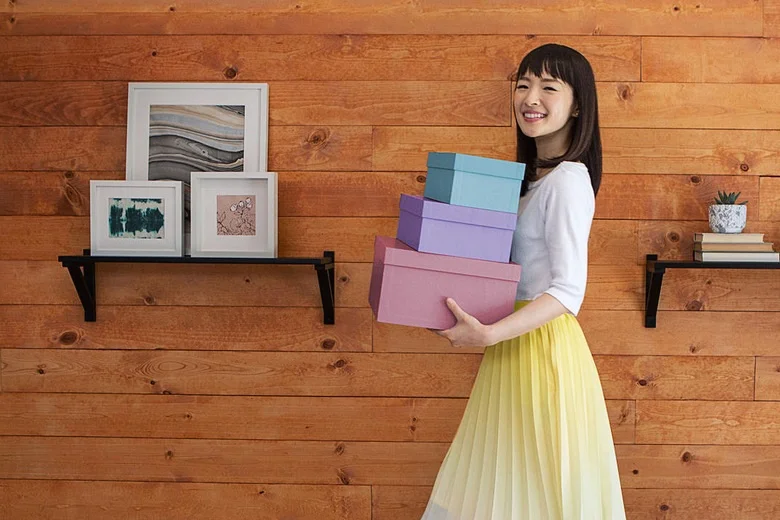
BLOG
How to get over self-sabotaging thoughts and feelings? Part 1 of 3.
This is the first in a three-part series about limiting beliefs: how to identify them, uncover their emotional power, and ultimately transform them into thoughts that “spark joy" and help you move forward with meaning.
Marie Kondo has helped millions of people rid their homes of objects that clutter their lives.
“My mission is to spark joy in the world through tidying,” she says in the first episode of her Netflix series Tidying Up with Marie Kondo before we meet an overwhelmed couple with two young kids and a house busting at the seams.
“The cluttered house seems to be affecting their relationship as well,” says Kondo about Rachel and Kevin, the exhausted homeowners and young couple who are having a seriously hard time liking each other.
“I would like to help this couple focus on what matters most to them, time with their family,” she continues before helping them bring light and joy back into their home. And, more importantly, back into their couple.
Where focus goes, the energy flows.
By asking people to wake up their objects, hold them close and look for a spark of joy in their bodies, Marie Kondo is teaching people how to identify and focus on what's most important.
She’s also helping people learn a physical and emotional language in order to do so— a new tool to put in their self-development toolbox.
What I love about her concept, dear reader, is how poetic and simple it is.
And how it can be applied not only to objects, but also to the beliefs in your head.
Click over to find out what I mean by that.
This is the first in a three-part series about limiting beliefs: how to identify them, uncover their emotional power, and ultimately transform them into thoughts that “spark joy" and help you move forward with meaning.
Marie Kondo has helped millions of people rid their homes of objects that clutter their lives.
“My mission is to spark joy in the world through tidying,” she says in the first episode of her Netflix series Tidying Up with Marie Kondo before we meet an overwhelmed couple with two young kids and a house busting at the seams.
“The cluttered house seems to be affecting their relationship as well,” says Kondo about Rachel and Kevin, the exhausted homeowners and young couple who are having a seriously hard time liking each other.
“I would like to help this couple focus on what matters most to them, time with their family,” she continues before helping them bring light and joy back into their home. And, more importantly, back into their couple.
Where focus goes, the energy flows.
By asking people to wake up their objects, hold them close and look for a spark of joy in their bodies, Marie Kondo is teaching people how to identify and focus on what's most important.
She’s also helping people learn a physical and emotional language in order to do so— a new tool to put in their self-development toolbox.
What I love about her concept, dear reader, is how poetic and simple it is.
And how it can be applied not only to objects, but also to the beliefs in your head.
Here what I mean by that.
Our beliefs play a huge role in our experiences. They are the thoughts that shape our perception of ourselves and the world.
Some beliefs help us move forward.
“There’s no such thing as failure, only feedback.”
“Where there’s a will, there’s a way.”
“Clarity comes through action.”
Some beliefs keep us back.
”You need to be certain that it will work before you start.”
“Money equals success.”
“You need to lie, cheat and steal to get to the top.”
Beliefs are not facts. They are thoughts, myths or generalities that we perceive as truths.
How do these thoughts become “truths?”
Because we overhear them growing up.
Because we acquire them socially.
Because we cultivate them to fit it.
Because we nurture them to create a certain life view and identity.
Because we haven’t found a reason or evidence not to believe them.
In coaching, one of the big things we do is work on identifying and tidying up the beliefs in your head. The ones that tend to drag you down, hold you back, distract you from what you really want.
Like the boxes of junk that you keep tripping over — you don’t have to keep beliefs that are holding you back!
You have the control to kindly say au revoir to the beliefs that are holding you back. “Thank you for your service, for protecting me and looking out for me, for helping me feel safe, or connected, but you no longer serve me now.”
Change the belief and you can change your emotional reaction to something, and therefore how you feel and respond to any situation.
So, dear reader I ask you to do the following thing this week as a little Marie Kondo experiment:
Keep a notebook or journal with you for one week and write down any thoughts, or annoying voices that leave a bitter taste in your mouth. That drag you down. Make you feel shitty. Hold you back from being a more joyful you.
Just like that pair of skinny jeans from twenty years ago that you dream of one day fitting into again but that chances are you won’t and that just serve to remind you of how you’re getting older and you’re body isn’t what it once was. Wouldn’t it be lovely to just thank those jeans for their years of service and send them packing?
So for now, when you hear those “skinny jeans” beliefs pop up in your head, write them down.
And I’ll be back in a couple of weeks to guide you through the next step: how to uncover the emotions that are attached to your beliefs.

